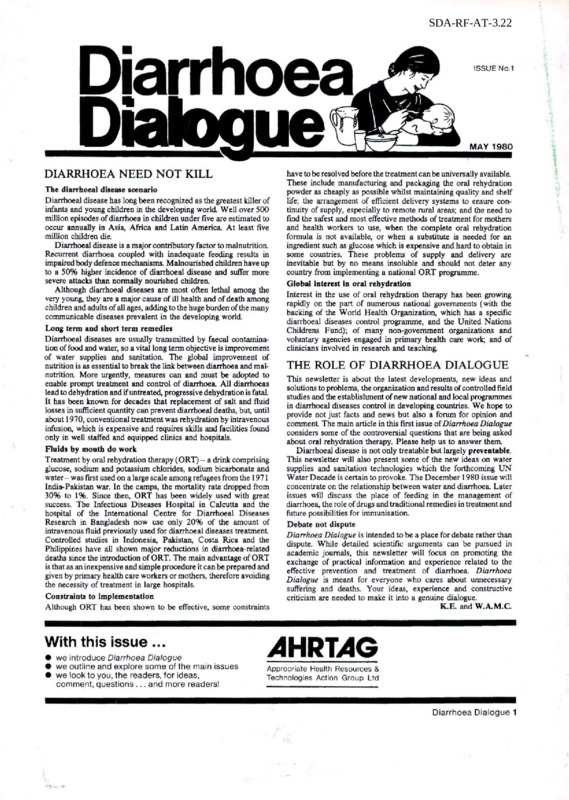SDA-RF-AT-3.22.pdf
Media
- extracted text
-
SDA-RF-AT-3.22
Diarrhoea
Dialogue
DIARRHOEA NEED NOT KILL
The diarrhoeal disease scenario
Diarrhoeal disease has long been recognized as the greatest killer of
infants and young children in the developing world. Well over 500
million episodes of diarrhoea in children under five are estimated to
occur annually in Asia, Africa and Latin America. At least five
million children die.
Diarrhoeal disease is a major contributory factor to malnutrition.
Recurrent diarrhoea coupled with inadequate feeding results in
impaired body defence mechanisms. Malnourished children have up
to a 50% higher incidence of diarrhoeal disease and suffer more
severe attacks than normally nourished children.
Although diarrhoeal diseases are most often lethal among the
very young, they are a major cause of ill health and of death among
children and adults of all ages, adding to the huge burden of the many
communicable diseases prevalent in the developing world.
Long term and short term remedies
Diarrhoeal diseases are usually transmitted by faecal contamina
tion of food and water, so a vital long term objective is improvement
of water supplies and sanitation. The global improvement of
nutrition is as essential to break the link between diarrhoea and mal
nutrition. More urgently, measures can and must be adopted to
enable prompt treatment and control of diarrhoea All diarrhoeas
lead to dehydration and if untreated, progressive dehydration is fatal
It has been known for decades that replacement of salt and fluid
losses in sufficient quantity can prevent diarrhoeal deaths, but, until
about 1970, conventional treatment was rehydration by intravenous
infusion, which is expensive and requires skills and facilities found
only in well staffed and equipped clinics and hospitals.
Fluids by mouth do work
Treatment by oral rehydration therapy (ORT) - a drink comprising
glucose, sodium and potassium chlorides, sodium bicarbonate and
water- was first used on a large scale among refugees from the 1971
India-Pakistan war. In the camps, the mortality rate dropped from
30% to 1%. Since then, ORT has been widely used with great
success. The Infectious Diseases Hospital in Calcutta and the
hospital of the International Centre for Diarrhoeal Diseases
Research in Bangladesh now use only 20% of the amount of
intravenous fluid previously used for diarrhoeal diseases treatment
Controlled studies in Indonesia, Pakistan, Costa Rica and the
Philippines have all shown m^jor reductions in diarrhoea-related
deaths since the introduction of ORT. The main advantage of ORT
is that as an inexpensive and simple procedure it can be prepared and
given by primary health care workers or mothers, therefore avoiding
the necessity of treatment in large hospitals.
Constraints to Implementation
Although ORT has been shown to be effective, some constraints
With this issue...
• we introduce Diarrhoea Dialogue
• we outline and explore some of the main issues
• we look to you, the readers, for ideas,
comment, questions ... and more readers!
ISSUE N0.1
7
MAY 1980
have to be resolved before the treatment can be universally available.
These include manufacturing and packaging the oral rehydration
powder as cheaply as possible whilst maintaining quality and shelf
life; the arrangement of efficient delivery systems to ensure con
tinuity of supply, especially to remote rural areas; and the need to
find the safest and most effective methods of treatment for mothers
and health workers to use, when the complete oral rehydration
formula is not available, or when a substitute is needed for an
ingredient such as glucose which is expensive and hard to obtain in
some countries. These problems of supply and delivery are
inevitable but by no means insoluble and should not deter any
country from implementing a national ORT programme.
Global interest in oral rehydration
Interest in the use of oral rehydration therapy has been growing
rapidly on the part of numerous national governments (with the
backing of the World Health Organization, which has a specific
diarrhoeal diseases control programme, and the United Nations
Childrens Fund); of many non-govemment organizations and
voluntary agencies engaged in primary health care work; and of
clinicians involved in research and teaching
THE ROLE OF DIARRHOEA DIALOGUE
This newsletter is about the latest developments, new ideas and
solutions to problems, the organization and results of controlled field
studies and the establishment of new national and local programmes
in diarrhoeal diseases control in developing countries. We hope to
provide not just facts and news but also a forum for opinion and
comment The main article in this first issue of Diarrhoea Dialogue
considers some of the controversial questions that are being asked
about oral rehydration therapy. Please help us to answer them.
Diarrhoeal disease is not only treatable but largely preventable.
This newsletter will also present some of the new ideas on water
supplies and sanitation technologies which the forthcoming UN
Water Decade is certain to provoke. The December 1980 issue will
concentrate on the relationship between water and diarrhoea. Later
issues will discuss the place of feeding in the management of
diarrhoea, the role of drugs and traditional remedies in treatment and
future possibilities for immunisation.
Debate not dispute
Diarrhoea Dialogue is intended to be a place for debate rather than
dispute. While detailed scientific arguments can be pursued in
academic journals, this newsletter will focus on promoting the
exchange of practical information and experience related to the
effective prevention and treatment of diarrhoea Diarrhoea
Dialogue is meant for everyone who cares about unnecessary
suffering and deaths. Your ideas, experience and constructive
criticism are needed to make it into a genuine dialogue.
K.E. and W.A.M.C
/1HRT/1G
Appropriate Health Resources &
Technologies Action Group Ltd
Diarrhoea Dialogue 1
Position: 1865 (3 views)
